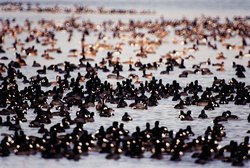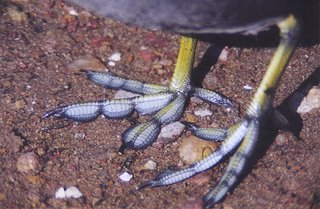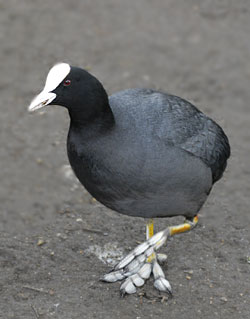


OK Norm, you made me laugh with the Old Coot remark on your blog...so you get the honor of ...The American Coot!
I am sure you have all encountered many at your local park,mixing with the ducks.
I have to say, their feet are rather intriguing...Check those big paddles out!


9 comments:
The American coot! LOL
That is the real name,Joy..heehee
I love the Coot, so beautiful and their feet are so very cool, they look like little starfish.....:)
I've never seen those before. Bird, do the migrate?
WOW!
What an odd looking bird.
Flix...Here is some info...
I can't believe you guys don't have these..we have zillions and zillions at the parks.
American Coot by Michael A. Seymour
© Michael A. Seymour
Fulica americana
This well-known slate-gray bird is the size of a small duck. It can be distinguished from a duck by its chickenlike, white bill. It resembles the Common Gallinule, which, however, has a red bill. The poule d' eau, as the coot is called in southern Louisiana, can be found on freshwater lakes and brackish ponds throughout the state in large numbers in fall, winter, and early spring. Sometimes we see coots making their way through the water like dark little ducks, nodding their heads forward and backward as they swim along. But they do not have webbed feet as do ducks. Their toes are equipped instead with flaps or lobes, which act as paddles. Usually coots stay closer to the shore than ducks; for, though they can be eaten, they are not as frequently hunted here during the gunning season and are not as shy. Often they come right out on the shore and walk around like chickens with feet two sizes too big. If we frighten one, however, or chase it in a boat, it spreads its wings and skitters away over the surface of the lake, splashing water in every direction before it finally manages to rise into the air.
Formerly in the winter as many as ten thousand coots could be counted on False River, in Pointe Coupee Parish, but now they are no longer seen there in such large concentrations, probably because of the growing popularity of outboard motorboating on this body of water. In spring, nearly all our coots migrate northward. A few remain in the state, mating and laying 8 to 14 speckled buff eggs on a platform woven of reeds or sedge back in the marsh vegetation. Such a nest was found on the Lacassine National Wildlife Refuge on April 15, 1956, by Leslie Glasgow; Edward McIlhenny Simmons found a brood of young at Avery Island in the spring of 1960; and Robert B. Hamilton and Robert E. Noble discovered two nests at the Natchitoches Fish Hatchery in June and July 1970 and photographed one clutch.--George H. Lowery, Jr., 1974, Louisiana Birds
Birds of Louisiana djl
LOS Homepage
Bird, they must be west coast critters. I would remember seeing one, they're so distinct. I like them!
Look at those crazy feet!
Those feet are cracking me up!
Post a Comment